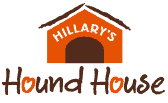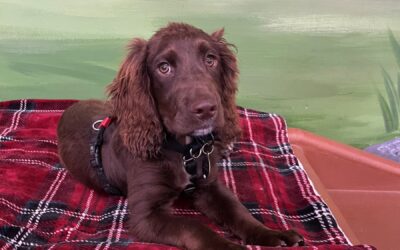Sometimes a dog can become frightened of something he’s known his entire life. Take Ralph, an 18 month old beagle that developed a terror of grocery carts. Ralph had excelled in our Jumpstart Puppy Program as a youngster and knew the in’s and out’s of grocery carts at 14 weeks. It took a fateful combination of events, a perfect storm that left him trembling and unable to go near a cart a year later. Here we’ll share with you how we helped Ralph conquer his fears.
Ralph and The Perfect Storm
Ralph was a beagle puppy that graduated from our Day Training Program at 6 months old. He’d been an easy going, confident little guy that learned quickly, loved working for treats and took new things in stride. Life was a bowl of biscuits for Ralph, who went everywhere with his two boys, Mattie and Mark (ages 8 and 10) and their mom, Jeanette. That’s why I was surprised to hear he had developed a fear of the grocery store and shopping carts.
When I met Ralph for the first time he was a about 15 weeks old. I remember the boys taking him around in a wagon, which he seemed to enjoy. This was a good thing, because later on Mattie and Mark would put him in shopping carts (wherever it was allowed, and some places where it wasn’t) and follow their mother while she shopped.
Ralph and Jeanette were leaving a store one day when a thunderstorm broke out. The first clap rumbled downward, then the rain came hard and fast. Jeanette grabbed Ralph, threw him in the grocery cart and made a run for the car. It was a wild ride that might’ve been fun had it not been for the thunder, Jeanette’s startled response and the clattering sounds of the shopping cart as it flew across the lot.
By the time they reached the car Ralph was trembling. Thinking he was wet and cold, Jeanette toweled him off and forgot about it. But two days later as she drove Ralph and the boys into the store parking lot they heard a strange sound. Jeanette and the boys looked down to find Ralph cowering on the floor of the car, whining and looking up at them pitifully. They managed to get him out of the car, but he seemed to melt as a grocery cart went by. That’s when he started to howl.
Jeanette called me that afternoon and we got to work immediately. I was concerned because the longer situations like this go on the more miserable a dog gets. Humans aren’t that different; the longer we’re frightened of something the longer it can take to get over it. We didn’t want that for Ralph.
The next day was Saturday and Jeanette, Matt and Mark joined me as I started with a refresher course. It was Day Training all over again as I put Ralph through his paces. It had been close to a year but he remembered everything; Recall in the Mall (coming to me on command in a crowded place), and Orbit Me (following me off-leash through a crowd), sitting to ask for treats. He was on, and we were ready.
Our next stop was a quiet street about a block from the grocery store. I parked and we headed that way, working as we went. I had a training halter on Ralph, something like a Haltie. I like these, “collars” because you can interrupt lots of behaviors with it by gently bringing a dog’s face back toward yours. Once you have his attention again you give him a treat, he once again focuses on you and you’ve interrupted a spiral of fearful and fear-enhancing behaviors.
As we approached the parking lot Ralph heard the clatter of a cart. He stiffened, stopped in his tracks, inhaled sharply and may have meant to howl. I didn’t wait to find out. Gently, pulling his head back toward mine I pulled out the pièce de résistance, a treat no dog can resist and something I use in the most dire of situations; grilled New York steak. As the scent of it wafted toward him, Ralph’s eyes cleared and he was back. We worked all the way into and through the parking lot with Ralph walking with me, watching me and sitting for bits of steak. We got about 20 feet from the line of carts when Ralph began to stiffen again. I felt it was time to stop the exercise on a good note and we exited and walked back to the van.
We resumed the next day, following the same protocol and working our way toward the grocery store lot. Ralph was on his game, more confident now and less hesitant (not having had breakfast helped a lot). We followed the same path as the day before. This time, as we approached the line of carts I asked the boys to quietly go and choose a cart and stand near it – without moving or paying attention to us. As Matt and Mark spoke between themselves, studiously trying to ignore us I continued to move forward with Ralph, who watched me intently and sat whenever I stopped. Before long, we were standing near the cart and Ralph seemed to be ok with it. We let him sniff the cart, walk around it and fed him more bits of steak. Then we went home.
We continued this exercise for a few more days until Jeanette could do it on her own. Ralph did fine and by the end of the week she was able to push a cart while Ralph walked next to her on a leash. In a final session I worked with the boys and taught them what to do as well, in case Ralph became tense or nervous again.
The part I couldn’t reproduce was the rainstorm and thunder, so we found a CD filled with storm sounds and played it in the house while I worked with Ralph, giving him treats every time the thunder hit. This worked well and we were able to boost the volume while the boys gave Ralph treats. Before long they could play lots of thunderous sounds and Ralph didn’t blink. In fact he began to associate those sounds with treats and never again became fearful during loud thunder storms. I’ve used this with dogs that are terrified of fireworks too, and it works well. You can find CD’s of just about any sound on-line, from a new baby crying, sirens, honking and more.
Dogs sometimes develop superstitious fears of things, places, even people and Ralph’s unfortunate experience is a prime example of this. What I did was to use a behavior modification program that included counter-conditioning, classical and operant conditioning to pair more positive, pleasurable experiences with the feared object – the grocery cart, then the thunder.
What it all means…
Behavior modification is a wonderful way to quickly and painlessly change a dog’s negative perception of something. It’s highly preferable to forcing a dog to “face his fears,” which can end one behavior, only to have the fear resurface in another way.
In the operant conditioning part I worked Ralph in ways that had him trying to figure out what I wanted. When he got it right (and he did because of our training review), he got the steak. Having to work mentally is harder for a dog than physical exercise and focusing like this really helps a dog forget what’s around him. I just had to be careful not to get so close to the cart in the beginning that his anxiety would overwhelm him. That’s why you want to proceed slowly. Here’s our motto: The slower you go the faster you get there.
The counter-conditioning aspect means we created, or conditioned a new response to replace the old one; fear. Ralph sees the cart and now associates it with pleasure; treats. Finally classical conditioning goes back to Pavlov and his dogs, who heard a bell, then got a treat. Before long they salivated every time they heard the bell in anticipation of getting a treat. The bell was now paired with food. For Ralph, the cart is now paired with treats. Over time Ralph may not remember exactly why he loves seeing those grocery carts. We’re just glad he does.
Whatever the cause, be it trauma, treatment or an escalation of challenging behaviors it is important to include re-socialization with your behavior modification treatment plan.



